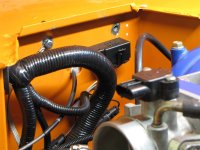What's the general condition of the electrical system on your rig Gray?
Reason I ask is that aluminum is generally more susceptible to damage from electrolysis and most EB's don't have enough grounds to reduce the possibility.
And it might be just about that age to have been effected by it.
With fewer ground paths for the general flow of electricity to follow on a typical EB, especially if the wiring has been futzed with, the coolant acts as a pathway for the current. When this happens, the metals deteriorate.
Cast iron can handle it for a long time.
Copper/brass a little less.
Aluminum much less.
Have you replaced the coolant since you bought the truck a year and a half ago? They're also more susceptible to the deterioration of anti-freeze than the copper/brass radiators are. So anyone with an aluminum radiator should more religiously follow the manufacturers recommendations. Like changing the coolant every other year or whatever it is these days.
I'd be a lot of Broncos don't get that much love. With the old radiators that was not as big a deal. With new ones, more of a big deal.
Not saying aluminum is bad. Just saying we have to do a few more things to keep them happy.
Such as:
1. Do you have a sacrificial anode in either the radiator cap ("Rad-Cap") or the drain plug?
2. Is the coolant less than 2 years old?
3. Are the mounts in good shape, so as not to add additional stresses to the seams, or to connect the radiator to the body electrically?
None of these things may be at issue here, of course. You might just have a good old standard leak. It happens even to aluminum radiators.
Personally, with no warranty or cheap fix available, and with such a small leak, I would flush it out, put new coolant in it, and add one of the new generation of fix-a-leak chemicals to the mix.
I use Solv-Tec sealant, which is considered (at least by the manufacturer) to be potentially a permanent fix. I've used it in several cases and can't argue the results. Or refute the "permanent" claim either, since so far every one of them is still running leak free at this point.
Including a fairly highly strung Audi Quattro A5 with a leaky head gasket (leaking into the number 4 cylinder) that runs better than it has in a long time and no longer sets off a check-engine light.
At this point, it's one of those, what do you have to lose scenarios.
But I understand the added concern if you're planning to use this Bronco out in the boonies. Seems better to fix the leak the old fashioned way at that point. But if that's not an option, or if it's not an available option immediately, the chemical fix might be a good temporary measure.
Or, as I like to say... "Temporary unless it works!"

Paul













